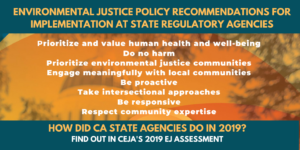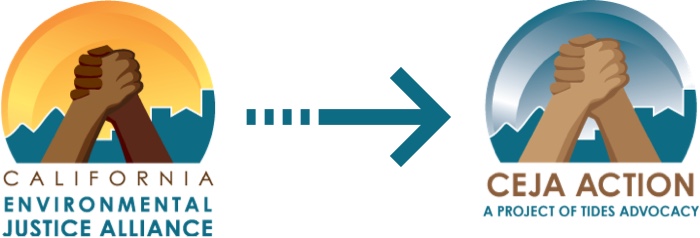2019 Environmental Justice Agency Assessment
Elected officials and legislation may get the majority of headlines, but California’s regulatory agencies wield vast power in decision-making that directly affects whether and how disproportionate environmental impacts on communities of color are remedied or exacerbated. For years, CEJA’s members and partners have deeply engaged in state agencies’ proceedings, raising our voices to advocate for the priorities of residents who have the most to gain and the most to lose from agencies’ decisions.
From rule-making processes, allocation of resources, permitting and regulation of industry, monitoring and enforcement, agency action or inaction can be determinative of the health and welfare, and overall life expectancy, of entire communities.
Download the Executive Summary
Read the full 2019 Environmental Justice Agency Assessment now!
Based on CEJA’s members and partners’ experiences advocating before state regulatory agencies,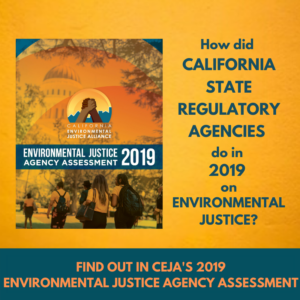 the need to evaluate our collective experiences and document issues systematically in the form of this agency assessment has become increasingly clear.
the need to evaluate our collective experiences and document issues systematically in the form of this agency assessment has become increasingly clear.
CEJA is proud to release our 2019 Environmental Justice Agency Assessment — the only report in the nation to formally examine how state agencies perform through an environmental justice lens.
Some Growth, But Vast Need for Improvement
Compared to our 2018 EJ Agency Assessment, five agencies improved their grades, resulting in slight increases across the board.
Building from 2018, the Strategic Growth Council (SGC) continued setting the standard, earning an A- grade.
Other agencies that earned “B” grades or higher include the State Water Resources Control Board and Coastal Commission. We applaud these agencies’ commitment to actualizing environmental justice principles in their work in 2019.
Despite this progress, the statewide agencies averaged a mediocre “C” grade — reflecting an overall failure to grasp the critical need to center people and equity in their work in order to achieve a healthy, sustainable, and prosperous environment for all Californians.
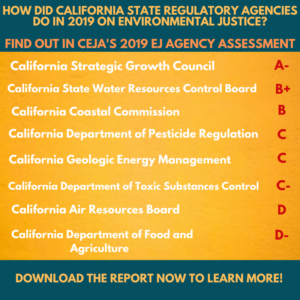 The COVID-19 pandemic and intersecting racial injustice pandemic have made it clearer than ever that environmental justice communities require meaningful investment and prioritization from regulatory agencies charged with protecting the environmental health of residents.
The COVID-19 pandemic and intersecting racial injustice pandemic have made it clearer than ever that environmental justice communities require meaningful investment and prioritization from regulatory agencies charged with protecting the environmental health of residents.
Of several agencies that underperformed, the California Air Resources Board (CARB) dropped a full letter grade due to its failure to reduce emissions in disproportionately polluted areas and refusal to include tangible emissions reductions as part of the AB 617 Community Air Protection Program.
Another disappointing performance came from CEJA’s first ever evaluation of the Department of Food and Agriculture (CDFA), whose Dairy Digester program continues to threatens the air and water quality of the state’s more vulnerable regions.
Across the board, our EJ Agency Assessment finds far too many state agencies either settling for satisfactory performance, or simply failing their commitments to environmental justice.
Download our full 2019 Environmental Justice Agency Assessment now.
More Relevant Now Than Ever
The two global crises we’re currently facing — the COVID-19 pandemic and systemic racism– have brought into sharp focus  truths that must be applied to our state agencies’ performance.
truths that must be applied to our state agencies’ performance.
First, as EJ community members and advocates, we know that public health is far more encompassing and complex than the discrete health outcomes we experience as individuals. The spread of COVID-19 has proven most lethal for Black communities, communities of color and low income communities. Agency failures to protect respiratory health among at-risk populations are particularly glaring.
Second, the racial inequities that plague our society ranging from the justice system to environmental health must be addressed — now. Our state agencies bear a duty to practice intersectional approaches, recognizing connections between environmental, climate, racial and economic justice.
Now more than ever, we need our state officials to fulfill mandates that protect the public’s health and safety and advance environmental justice, and to double-down on commitments to do so justly and equitably.
The Path to Change: Key Recommendations
Our EJ Agency Assessment includes recommendations for twelve agencies on how to advance environmental justice principles and work toward a safe, healthy and equitable future for all Californians. The following are examples of these recommendations:
California Air Resources Board (CARB) — Take accountability for its failure to enact tangible emissions reductions in EJ communities by incorporating the priorities of these communities into CARB’s work across sectors, and through enforceable regulations and mandates to improve air quality for impacted regions.
California Department of Pesticide Regulation (DPR) — Adopt plans with annual benchmarks to help growers reduce use of the most hazardous pesticides and re-align staff and resources to prioritize supporting growers’ adoption of reduced-risk crop and pest management.
California Department of Toxic Substances Control (DTSC) — Prioritize reducing hazardous waste generation at its source to avoid the inevitable shifting of pollution burdens from one community to another.
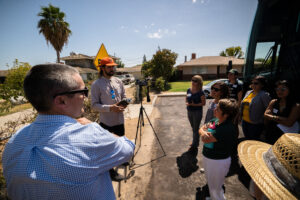 California Geologic Energy Management Division (CalGEM) — Adopt a health and safety setback of at least 2,500 feet between oil/gas wells and homes, hospitals and schools.
California Geologic Energy Management Division (CalGEM) — Adopt a health and safety setback of at least 2,500 feet between oil/gas wells and homes, hospitals and schools.
California State Water Resources Control Board — Be responsive to community input as it implements the Safe and Affordable Drinking Water Fund.
California Strategic Growth Council (SGC) — Take more leadership in proactively increasing funding for Transformative Climate Communities (TCC), an effective but underfunded program.
California Coastal Commission — Create clear guidance for staff on identifying environmental justice issues, and then develop mitigations and alternatives.
California Department of Food and Agriculture (CDFA) — Reconsider investment in Dairy Digesters, focus on supporting technical assistance and transformative programs that support farmers to implement agroecological practices. Develop community engagement strategies to further elevate input of communities impacted by farming and farmworkers.
California Department of Water Resources — Prioritize drinking water in the evaluation of Groundwater Sustainability Plans, and ensure EJ communities do not experience barriers to participate in feedback gathering on implementation plans.
California Energy Commission (CEC) — Ensure community-based organizations do not face unnecessary barriers navigating, applying for and receiving competitive grants for offerings like the Electric Program Investment Charge (EPIC) Program.
California Public Utilities Commission (CPUC) — Integrate socioeconomic and neighborhood vulnerability factors and community input into the utilities’ climate planning frameworks. Launch BUILD and TECH programs now, without creating more studies or multiple budget approvals — EJ communities need these programs now.
California Natural Resources Agency (CNRA) — Establish an executive-level Environmental Justice position and allocate resources to community groups for engaging in rule-making in ways that align with the CPUC intervenor status.
